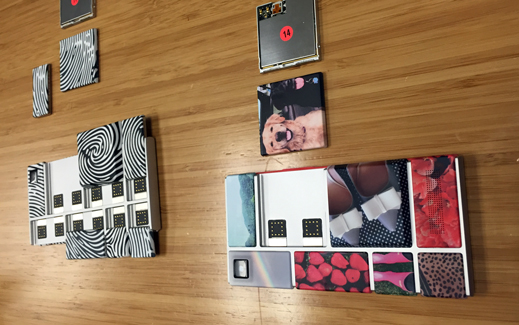Google’s Modular Smartphone to Debut in Puerto Rico
Google’s vision of cheap modular smartphones made up of interchangeable pieces is getting closer to reality. The company showed off the latest prototype on Wednesday, and said that it will start selling its first modular phone in Puerto Rico later this year.

Google’s Advanced Technology and Projects (ATAP) group revealed the Spiral 2 on Wednesday during a crowded event for software developers at a Google office in Mountain View, California. It is a slim handset, its face dominated by a large display and a receiver module for phone calls that includes a light and proximity sensor on the front. On the back are eight different square and rectangular modules that snap into the phone’s slim metal skeleton to add different functions to the device.
The modules on the back include a camera, USB charger, Wi-Fi, and Bluetooth radios, and the device’s main processor. The display and receiver module on the front can also be swapped out. All the modules are held in place by magnets in the device’s frame.
Google says that this modular approach, which it calls Project Ara, will lead to inexpensive smartphones that can be customized and upgraded by users depending on their budget or personal requirements. You might want a camera with an optical zoom lens for a sightseeing trip, for instance, a pollution sensor to keep tabs on asthma, or just a simple phone with basic capabilities.
But the Spiral 2 prototype also shows how tricky it will be for Google to make a modular gadget successful. The latest device comes about nine months after ATAP unveiled the first Project Ara smartphone prototype, Spiral 1, at a similar conference (see “For Project Ara, It’s Module—Not App—Ideas Wanted”). That earlier device had Wi-Fi but no working cellular connection, and failed to work when presented to the crowd. Spiral 2 did manage to power up in public and showed Google’s Android operating system on its display.

The Spiral 2 prototype is slimmer and looks more polished than the previous version. But the handset is still far from being the flashy device with night vision and a slew of other modules imagined in a promotional Project Ara video shown at the conference. Google’s prototypes have yet to catch up to existing smartphones on features such as cellular data speeds, for example.
Ara Knaian, the chief mechanical engineer for the project and also its namesake, said one tricky problem now solved is that the modules of the first prototype would disconnect themselves when a person sat down on the phone. In the newer version, the slots for the modules on the endoskeleton are made more precisely.
“Definitely we’ve made a lot of progress,” he said. “Of course, there’s still plenty to do.”
A Spiral 3 prototype is in the works and expected to be complete before June. Google says that device will be able to wirelessly transfer data between the modules and endoskeleton, eliminating the need for the spring-pin connectors used currently.
The next prototype is also slated to include a redesign of the magnets that keep the modules in place. Project Ara’s leader, Paul Eremenko, said the group hopes to get the phone to last for a full day, at least, though he then said that this might only happen by swapping in another battery at some point (Project Ara aims to let users do this without needing to turn off the phone). The design of the phone’s skeleton will also need to be modified so that it can be easily manufactured.
Google plans to start selling Ara phones to customers in Puerto Rico as a test market at some point this year, in collaboration with two wireless carriers. The phones will be sold from trucks that function as mobile stores, as well as over the Internet.
Just as third party apps were crucial to the popularity of smartphones, getting people interested in modular phones will hinge on companies other than Google offering a diverse selection of modules. Google has already started courting hardware companies to become module developers. On Wednesday, the company showed a preview of the online “Ara Marketplace” that will let developers sell Google-approved modules to consumers. Google is aiming to have a minimum of 20 modules available when it starts selling phones in Puerto Rico. Google has also come up with 11 different reference designs for modules for developers to use.
Electronics giant Toshiba and chip makers Marvell and Nvidia are among those already showing interest; Toshiba showed off some early camera modules at the conference. But the individual hardware developers I spoke with in the audience were still in the earliest stages of working on modules.
How much Project Ara modules might cost is unclear, but it must be low if Google is to attract people looking for their first smartphone. Eremenko said in April last year that the bill of materials for a basic Ara handset complete with display, Wi-Fi, battery, and processor modules would run about $50, though he didn’t put an estimated sale price on it. On Wednesday, he declined to update that figure.
Keep Reading
Most Popular
Large language models can do jaw-dropping things. But nobody knows exactly why.
And that's a problem. Figuring it out is one of the biggest scientific puzzles of our time and a crucial step towards controlling more powerful future models.
How scientists traced a mysterious covid case back to six toilets
When wastewater surveillance turns into a hunt for a single infected individual, the ethics get tricky.
The problem with plug-in hybrids? Their drivers.
Plug-in hybrids are often sold as a transition to EVs, but new data from Europe shows we’re still underestimating the emissions they produce.
Stay connected
Get the latest updates from
MIT Technology Review
Discover special offers, top stories, upcoming events, and more.